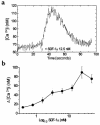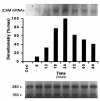Expression of functional CXCR4 chemokine receptors on human colonic epithelial cells
- PMID: 10525044
- PMCID: PMC408573
- DOI: 10.1172/JCI6685
Expression of functional CXCR4 chemokine receptors on human colonic epithelial cells
Abstract
In addition to their role as regulators of leukocyte migration and activation, chemokines and their receptors also function in angiogenesis, growth regulation, and HIV-1 pathogenesis--effects that involve the action of chemokines on nonhematopoietic cells. To determine whether chemokine receptors are expressed in human colonic epithelium, HT-29 cells were examined by RT-PCR for the expression of the chemokine receptors for lymphotactin, fractalkine, CCR1-10, and CXCR1-5. The only receptor consistently detected was CXCR4 (fusin/LESTR), although HT-29 cells did not express mRNA for its ligand, stromal cell-derived factor (SDF-1alpha). Flow cytometric analysis with anti-CXCR4 antibody indicated that the CXCR4 protein was expressed on the surface of roughly half of HT-29 cells. CXCR4 was also expressed in colonic epithelial cells in vivo as shown by immunohistochemistry on biopsies from normal and inflamed human colonic mucosa. The mRNA for SDF-1alpha and other CC and CXC chemokines was present in normal colonic biopsies. The CXCR4 receptor in HT-29 cells was functionally coupled, as demonstrated by the elevation in [Ca2+]i, which occurred in response to 25 nM SDF-1alpha and by the SDF-1alpha-induced upregulation of ICAM-1 mRNA. Sodium butyrate downregulated CXCR4 expression and induced differentiation of HT-29 cells, suggesting a role for CXCR4 in maintenance and renewal of the colonic epithelium. This receptor, which also serves as a coreceptor for HIV, may mediate viral infection of colonic epithelial cells.
Figures







Similar articles
-
Chemokine stromal cell-derived factor 1alpha activates basophils by means of CXCR4.J Allergy Clin Immunol. 2000 Aug;106(2):313-20. doi: 10.1067/mai.2000.108108. J Allergy Clin Immunol. 2000. PMID: 10932076
-
SDF-1/CXCL12 regulates cAMP production and ion transport in intestinal epithelial cells via CXCR4.Am J Physiol Gastrointest Liver Physiol. 2004 May;286(5):G844-50. doi: 10.1152/ajpgi.00112.2003. Epub 2003 Dec 18. Am J Physiol Gastrointest Liver Physiol. 2004. PMID: 14684377
-
Up-regulation of CXCR4 expression in PC-3 cells by stromal-derived factor-1alpha (CXCL12) increases endothelial adhesion and transendothelial migration: role of MEK/ERK signaling pathway-dependent NF-kappaB activation.Cancer Res. 2005 Nov 1;65(21):9891-8. doi: 10.1158/0008-5472.CAN-05-1293. Cancer Res. 2005. PMID: 16267013
-
Clinical importance and therapeutic implications of the pivotal CXCL12-CXCR4 (chemokine ligand-receptor) interaction in cancer cell migration.Tumour Biol. 2007;28(3):123-31. doi: 10.1159/000102979. Epub 2007 May 18. Tumour Biol. 2007. PMID: 17510563 Review.
-
A CXC chemokine SDF-1/PBSF: a ligand for a HIV coreceptor, CXCR4.Adv Immunol. 1999;71:211-28. doi: 10.1016/s0065-2776(08)60403-4. Adv Immunol. 1999. PMID: 9917914 Review. No abstract available.
Cited by
-
Stereospecific induction of apoptosis in tumor cells via endogenous C16-ceramide and distinct transcripts.Cell Death Discov. 2015 Jul 27;1:15013. doi: 10.1038/cddiscovery.2015.13. eCollection 2015. Cell Death Discov. 2015. PMID: 27551447 Free PMC article.
-
Expression of HIV receptors, alternate receptors and co-receptors on tonsillar epithelium: implications for HIV binding and primary oral infection.Virol J. 2006 Apr 6;3:25. doi: 10.1186/1743-422X-3-25. Virol J. 2006. PMID: 16600047 Free PMC article.
-
Interleukin 31 mediates MAP kinase and STAT1/3 activation in intestinal epithelial cells and its expression is upregulated in inflammatory bowel disease.Gut. 2007 Sep;56(9):1257-65. doi: 10.1136/gut.2006.118679. Epub 2007 Apr 20. Gut. 2007. PMID: 17449633 Free PMC article.
-
Aberrant T-cell ontogeny and defective thymocyte and colonic T-cell chemotactic migration in colitis-prone Galphai2-deficient mice.Immunology. 2007 Oct;122(2):199-209. doi: 10.1111/j.1365-2567.2007.02629.x. Epub 2007 May 9. Immunology. 2007. PMID: 17490434 Free PMC article.
-
Chemokines--linking receptors to response.Immunology. 2002 Feb;105(2):121-4. Immunology. 2002. PMID: 11872086 Free PMC article. Review. No abstract available.
References
-
- Yang SK, Eckmann L, Panja A, Kagnoff MF. Differential and regulated expression of CXC, CC and C chemokines by human colon epithelial cells. Gastroenterology. 1997;113:1214–1223. - PubMed
-
- Kennedy J, et al. Molecular cloning and functional characterisation of human lymphotactin. J Immunol. 1995;155:203–209. - PubMed
-
- Bazan JF, et al. A new class of membrane-bound chemokine with a CX3C motif. Nature. 1997;385:640–644. - PubMed
-
- Keane MP, Arenberg DA, Moore BB, Addison CL, Streiter RM. CXC chemokines and angiogenesis/angiostasis. Proc Natl Acad Sci USA. 1998;110:288–296. - PubMed
Publication types
MeSH terms
Substances
LinkOut - more resources
Full Text Sources
Other Literature Sources
Molecular Biology Databases
Research Materials
Miscellaneous

